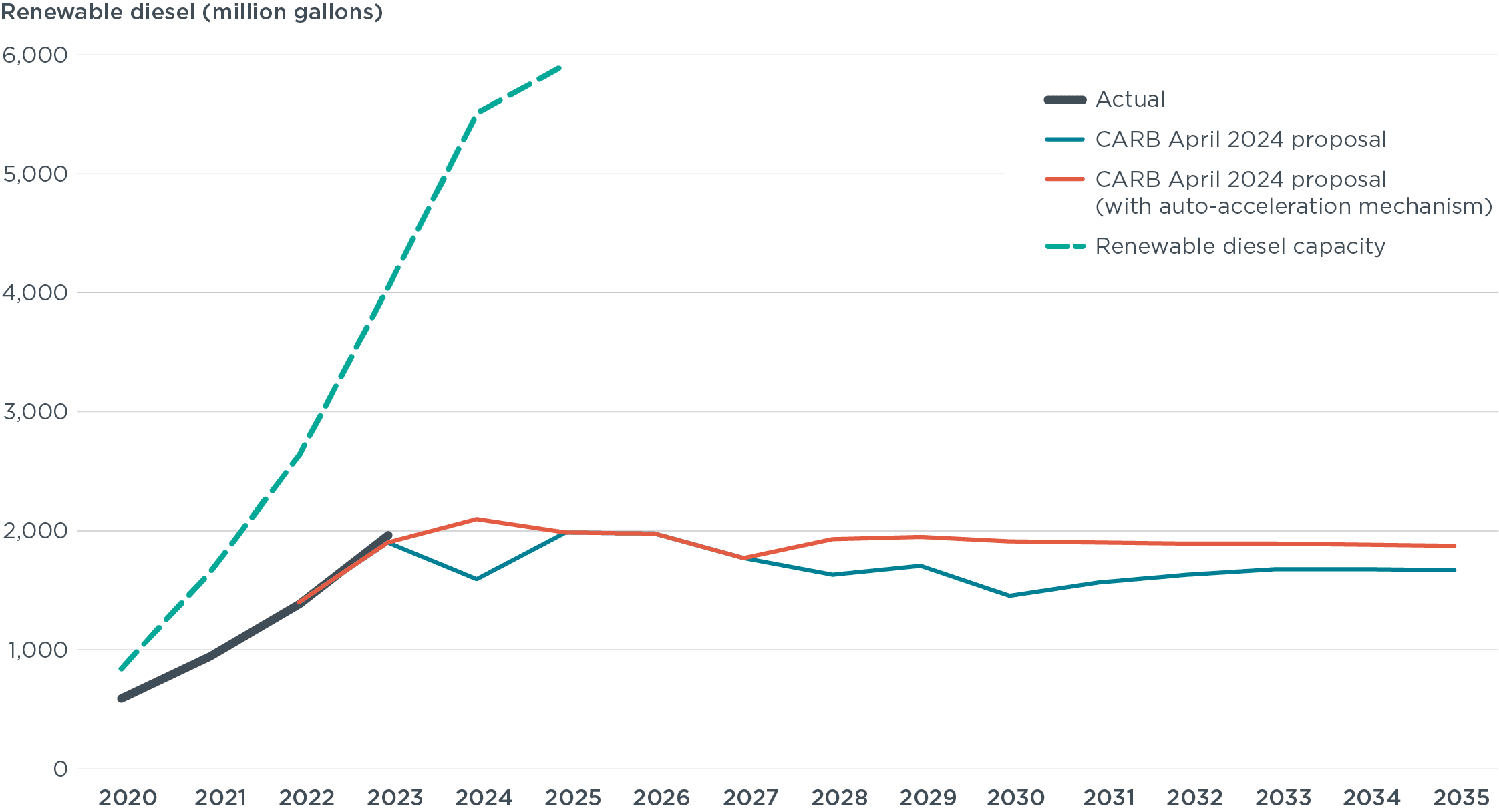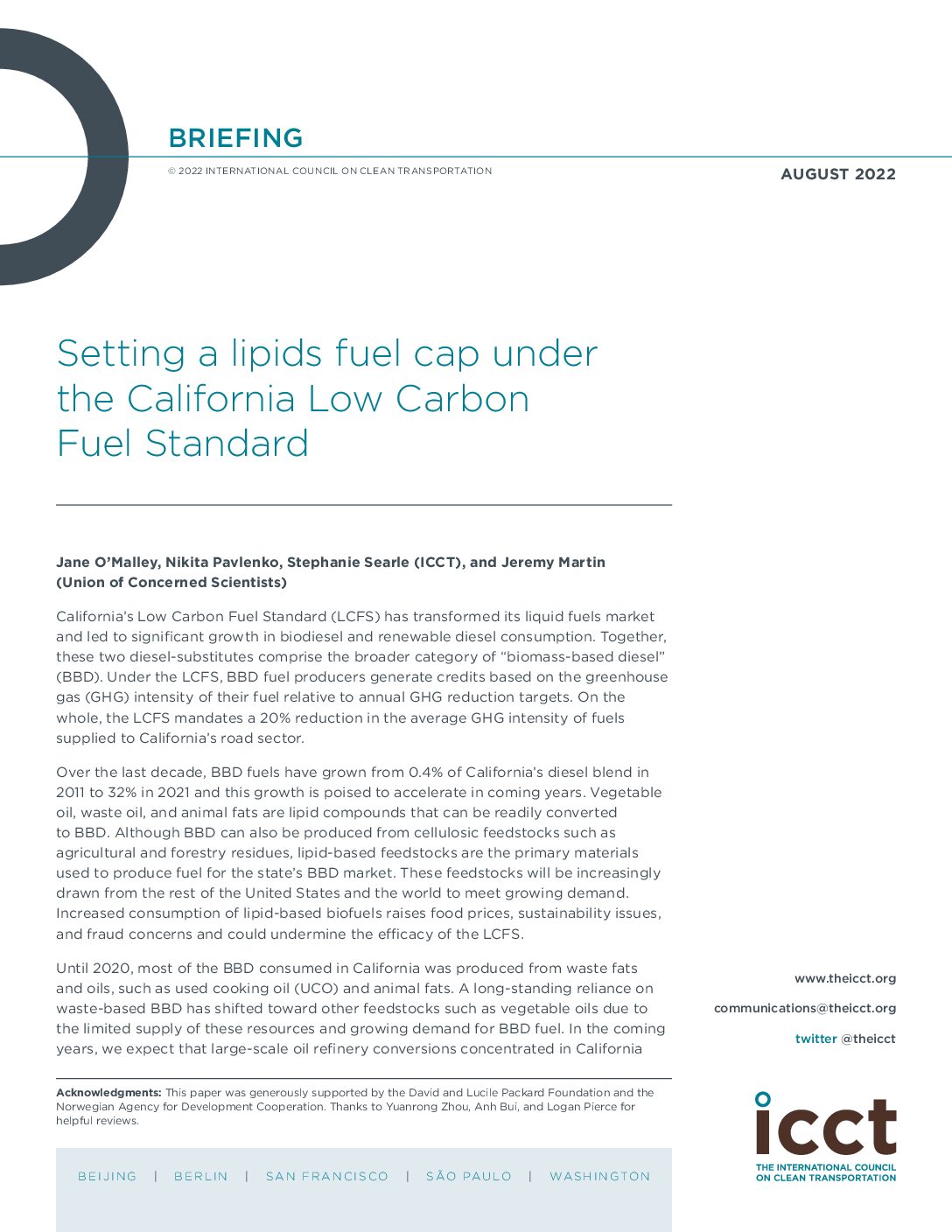Setting a lipids fuel cap under the California Low Carbon Fuel Standard
Blog
Delays in California’s LCFS revisions are an opportunity to improve
Earlier this year, the California Air Resources Board (CARB) postponed a hearing and vote to finalize revisions to its Low Carbon Fuel Standard (LCFS) until the Friday after the 2024 U.S. elections in November. The vote had been expected in March and it’s a good sign that CARB is taking more time. This delay is another opportunity to adjust the regulation so it can do more to achieve California’s climate goals.
The LCFS revisions were riven from the outset by temporally competing priorities. A quick, simple update that raises ambitions and greenhouse gas (GHG) reduction targets would be relatively straightforward. It would also lift the LCFS’s sagging credit market, which has fallen from pre-pandemic heights of $200 per tonne of carbon dioxide (CO2) to less than $75 per tonne in early 2024. Addressing several other issues that have cropped up over the last 5 years, including the program’s growing reliance on virgin vegetable oils and credits from avoided methane emissions at large dairy farms, would take much more time. The risk with spending that time is that it could prolong the slump in credit prices and thus erode the program’s near-term value to credit-generators such as electric vehicle charging stations and alternative fuel producers.
Under any circumstances, balancing these priorities would be a challenging. But now that there’s more time, let’s focus on the two largest issues—the risk that the LCFS is shuffling around or diverting resources and that it’s crediting GHG reductions from unrelated agriculture-sector projects. There are available policy levers to tackle both.
The resource-diversion issue is about the impact on vegetable oil markets. The LCFS’s historic success at driving the use of waste oil-derived renewable diesel is likely already bumping up against resource constraints for domestic waste oils because it’s bringing more virgin soy oil and more used cooking oil (UCO) from Asia into the state. An expanding reliance on virgin soy oil for LCFS compliance will probably shuffle existing soy oil mandated by the federal Renewable Fuel Standard (RFS) from other states to California. Look at the data—there’s an uptick in idled biodiesel capacity in the last 3 years, as conventional biodiesel consumed nationwide is giving way to renewable diesel production intended for the West Coast that can exceed FAME biodiesel blending constraints and be used for LCFS compliance. If new, higher targets are implemented, the LCFS could increase total demand for soy beyond federal mandates and lead to unintended market distortions and indirect land-use change emissions.
We’re beginning to see this in recent months, as the LCFS overshot the RFS mandate and caused the value of RFS RINs to plummet. This prompted some producers to reconsider their renewable diesel plans until a clear policy signal emerges.
Solution: An energy- or volume-based cap on the quantity of lipids (fats and oils) credited in the LCFS would reduce the program’s impact on biofuels linked to deforestation and minimize the risk of imported waste oil fraud.
The crediting issue is about avoided methane emissions. The LCFS credits farms for avoided methane emissions from improved manure management if they build digesters to capture the manure methane and send it to the gas grid. This doesn’t address additionality (i.e., whether those digesters were built solely because of the LCFS) or deliverability (whether the natural gas is being delivered to California and consumed in the transport sector). The types of large, concentrated farms that have benefitted most from this all-carrot, no-stick approach have also been criticized for their contribution to local air pollution. Ultimately, the concern is that the current design of the LCFS conflates its transport-sector goals with a nationwide carbon-offset system for farms.
Solution: Phase out avoided methane crediting for new pathway applications to the LCFS and implement deliverability requirements to demonstrate that new projects are producing fuel for the transport market.
CARB’s scoping workshops for the LCFS amendments identified several possible structural changes and singled out issues that had been highlighted by the ICCT and other organizations. But in the December 2023 proposed approach, there was no cap on the riskiest biofuels. Instead, there was language referring to sustainability certifications for biofuel producers; in the European Union, such certifications have been shown to have little impact on the indirect, market-mediated pressure that biofuel demand places on land use. Also under the December 2023 proposal, the avoided methane credits would only be phased in for new projects starting in 2030, while existing projects and those built prior to 2030 would be guaranteed an avoided methane credit for 30 years. Similarly, deliverability constraints—which could help limit the inflow of credits from farms as far away as Indiana and New York—would only be implemented starting in 2030 for renewable natural gas. As proposed, the deliverability requirements kick in starting in 2045 for hydrogen made from renewable natural gas, despite it being fossil-derived gray hydrogen paired with a tradeable credit for upstream biomethane production.
Data that has emerged over the last few months suggests the bigger, structural changes to the LCFS are imperative. Fourth quarter 2023 data from the LCFS, released after the proposal came out, showed that the use of lipid-based renewable diesel in California continued to accelerate and rose by over 40% compared with fourth quarter 2022. Analysis from UC Davis estimated that if the December 2023 amendments go through as proposed, they aren’t likely to stabilize credit markets and would instead expand California’s reliance on cheap, vegetable oil-based renewable diesel. Dan Sperling, a former CARB board member and one of the thought leaders who contributed to the design of California’s LCFS, warned in March that the proposed amendments risk exacerbating deforestation and “inaction risks sending one of California’s key climate policies off course.”
Recent data suggests that renewable diesel production is poised to continue growing beyond CARB’s expectations. Figure 1 illustrates the trajectory of reported lipid renewable diesel consumption in California through 2023 (in gray) and the Energy Information Administration’s projection of renewable diesel conversion capacity (the dotted line) through 2025; both contrast with CARB’s projections of projected renewable diesel consumption through 2035 (blue and orange lines). As you can see, CARB’s modeling suggests that, even with a big change in LCFS target levels and a new-auto-acceleration mechanism to ramp up compliance, California’s lipid demand for renewable diesel will essentially stabilize starting next year. But the rapid pace of renewable diesel conversion capacity suggests there’s plenty of flexibility to process greater volumes of lipids into renewable diesel in response to policy changes. It’s more likely that a higher target would exacerbate current trends and potentially push lipid consumption up by another billion gallons and approach a 100% renewable diesel blend. A lipids cap set at present-day levels is more likely to align the program with CARB’s expectations of consumption around 2 billion gallons annually.
Figure 1. Comparison of renewable diesel capacity, actual consumption, and CARB projections of future consumption, 2020-2035. Source: EIA and California Air Resources Board Dashboard and April ISOR Supplemental Documentation

So yes, the delay in the LCFS process is a great opportunity. CARB’s decision has implications that go beyond the State of California: Moving ahead without any additional safeguards may influence other states with fuels policies to do the same and could even create more pressure on the Environmental Protection Agency to increase the federal mandate. Rather than narrowly focusing on higher target levels, CARB can strike a balance that includes measures that address the quality of credits generated. Using this extra time to add guardrails such as a cap on lipids and greater restrictions on the crediting and deliverability of biomethane can achieve CARB’s goals of raising LCFS credit values and boosting the market by limiting the contribution of the cheapest, riskiest sources of credits.
Author
Related Publications

A policy safeguard is urgently needed to limit the impact of LCFS on food prices, trade imbalances, and deforestation.

